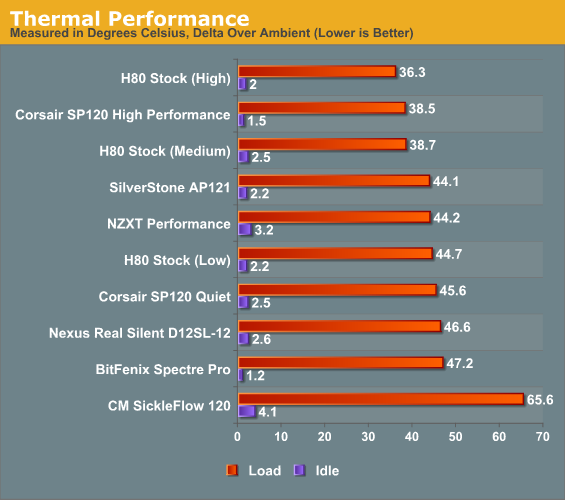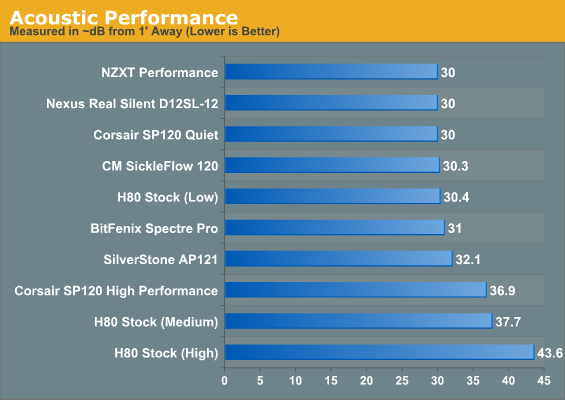Choosing the Best 120mm Radiator Fan: Testing Eight Fans with Corsair's H80
by Dustin Sklavos on August 23, 2012 12:01 AM ESTTest Results
Before we get into the performance results, a refresher: all eight fans on one chart for comparison. Note that if we're not taking noise into account, the highest static pressure fan should theoretically be the best performer. Our H80's fan settings are also only active with the stock fan; all others run at the full twelve volts.
| Fan | Airflow (in CFM) | Static Pressure (in mm/H2O) | RPM | Rated dBA |
| H80 Stock | 46-92 | 1.6-7.7 | 1300-2500 | 22-39 |
| SP120 Quiet |
37.85 |
1.29 | 1450 | 23 |
| SP120 High Performance | 62.74 | 3.1 | 2350 | 35 |
| SilverStone AP121 | 35.36 | 1.71 | 1500 | 22.4 |
| BitFenix Spectre Pro | 56.22 | 1.24 | 1200 | 18.9 |
| Nexus Real Silent D12SL-12 | 36.87 | 1.2 | 1000 | 18 |
| CoolerMaster SickleFlow 120 | 69.69 | 2.94 | 2000 | 19 |
| NZXT Performance | 47.27 | 0.95 | 1300 | 25.35 |
As far as static pressure goes, most of these fans are hanging out in about the same neighborhood. Acoustically, only Corsair's SP120 High Performance and stock H80 fan are even rated to go above the noise floor of our sound meter, though it's clear the stock fan is designed to move heat as fast as humanly possible. Let's see how all of these theoreticals worked out in practice, though.
Ambient temperatures ranged between 24C and 26C, and the margin for error in results is roughly 1C.

Thermally, if we ignore the H80's stock fan, the SickleFlow should've eaten the competition alive, but as it turns out CoolerMaster's specifications were more than just a little optimistic, as it was hands down the worst radiator fan we tested by a wide margin. If we organize the fans by rated static air pressure, they'd rank from best to worst: SP120 High Performance, SickleFlow 120, SilverStone AP121, SP120 Quiet, BitFenix Spectre Pro, Nexus Real Silent, and dead last, the NZXT Performance. As it turns out, though, only the SP120 High Performance really performs in line with its specifications; the rest just bunch up while the SickleFlow 120 is clearly the worst.
So how about acoustic performance?

Well, at least CoolerMaster's fan is quiet while it cooks your processor. To get that great thermal performance from the SP120 and H80 stock fan, though, you're going to have to put up with some noise. Note that these are load noise readings; the H80 stock fan idles at or below our sound meter's 30dB threshold at Low and Medium settings while sitting at 34.3 dB at High.
Interestingly enough, despite having among the worst rated specs, NZXT's Performance fan seems to find the best balance between thermal performance and acoustics; Corsair's SP120 Quiet does little to justify itself over the stock H80 fan. Corsair's engineers also turned out to be mostly right on the money: the H80 stock fan by and large seems to be the best choice, at least for the H80 itself. Its Low setting is competitive with the other fans both thermally and acoustically, while its Medium setting is competitive with the SP120 High Performance fan. The High setting is essentially unnecessary.










113 Comments
View All Comments
Rocket321 - Thursday, August 23, 2012 - link
I appreciated this review and would also like to see a round two, thanks Dustin!krumme - Thursday, August 23, 2012 - link
So people want 100 different coolers tested in 1000 different combinations, all with a spectrum analyzer plot.Sounds like tax payers demand for public service
May i remind you about the conlusion.
Stock cooler works fine
Sorry to hurt upgrade feelings and the eternal upgrade identity :)
Another excellent, spot on, work by Dustin.
ehume - Thursday, August 23, 2012 - link
I've done my own share of fan-testing. One is available in the AT forums, but the fuller cite is on OCN - The Well-Dressed Megahalems. I did an update on Vortez.net last month with 60 fans. My R4 Sickleflow does not fail the way this one did. It never even got warm, and performed pretty well. So I think Dustin got a bum copy.Actually, I have 2 CM Sickleflow 2000's. They both run around 2000 rpm. Dustin, check your fan speed. If it is not running about 2K, it's not working properly.
On Sickleflow specs: even CM has admitted that it only runs 19 dB if it is slowed down. Now, as to why they have not corrected their "typo" . . .
Overall, this is a nice beginning. I would suggest noting someplace that your setup is stable at various ambient temps. If you can leave the block bolted to the cpu you can return to it later to test other fans.
Over at OCN in the water cooling section Martinm210 did a bunch of fan-testing on rads, both 120mm and 140mm. Worth looking at. As for individual fans on a rad, I believe the Gentle Typhoon Ap-15 is the standard benchmark.
sirizak - Thursday, August 23, 2012 - link
I remember signing upto OCN to thank you for that article ehume.Thank you again, that was how you a fan roundup!
I posted a link to the original article earlier in the comments.
Can we get a link to the Vortez.net article please?
szimm - Friday, August 24, 2012 - link
I would have rather seen a review using the PWM version of the 120mm Bitfenix Spectre Pro, which is clearly built for radiator use - it has more than twice the static pressure of the non-PWM version.jabber - Friday, August 24, 2012 - link
They appear to work a treat. No complaints.I just looked for the one listed with the highest CFM for a set dB limit.
Not disappointed.
cyberguyz - Friday, August 24, 2012 - link
this review totally overlooked all the 120x38mm fans out there.Forget the CFM numbers. When dealing with a radiator it is the ability of the fan to force air through tghe radiator - particularly double-core radiators that counts.
CFM numbers are obtains from open-air movement with no restrictions. Many of the 25mm thick fans fall off really fast as soon as you restrict the output side of that airflow. A 38mm thick fan can use a steeper blade pitch to push that air harder through dense radiator fins.
I run a pair of Panaflow 'Ultra fast' fans with 115 cfm + 0.313 in H2O, 7.95 mm H2O, (78.0 Pa) on an H100 radiator.
While dang loud at full speed I can dial them back to 7v and keep my computer relatively sane-sounding. If things get a little warm I can speed them up as needed. Never had to take them to 100% (12v) though.
softdrinkviking - Friday, August 24, 2012 - link
I liked this comparison, but curious to see Sanyo Denki in the mix because they are pretty awesome fans. I think they may be a little high on acoustics, but they are extremely durable and very effective. (in personal experience)Also, my enermax fan has been really amazing in my current rig, I think it has a great balance of cool/noise.
I guess I think you need a wider test base. While it's great that your tests show that fans matter, there are just so many more options out there that there can't be a clear recommendation based on this article.
bigbluerobo - Friday, August 24, 2012 - link
if this review was posted 2 months sooner i would have saved 18 bucks with the CM sickle flows :(orclordrh - Friday, August 24, 2012 - link
The H80 has a fan speed feature, but for those of us with lesser rads (H-60 in my case) a PWM fan or fans are preferable for noise. I've been searching for two (push-pull) since replacing my CPU with a 3770k, and finding that it's a major meltdown waiting to happen. I tried a pair of Noctua F12s, nice design, shame about the airflow, now serving as case fans. I also tried a Coolermaster or two. I'm back with the stock Corsair on the outside, backed with a Coolermaster Excalibur, which is at least keeping the 3770 cool, but has little headroom for overclocking. At least it's quiet unless it's under load.